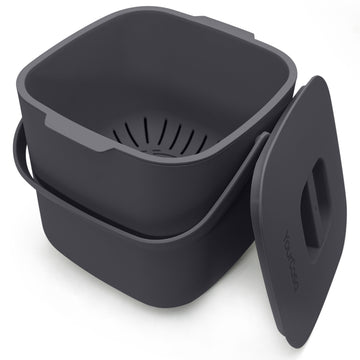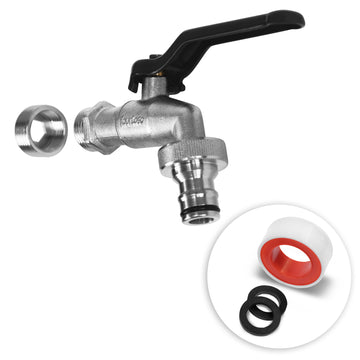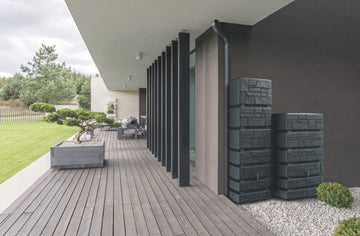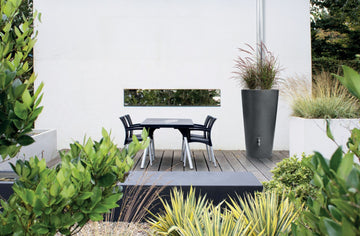
Have you seen the benefits of having a rain barrel in your garden and are you about to buy one? Then you might be wondering how big it should be - and that's a legitimate question.
In this article, you'll learn everything you need to know to determine the perfect rain barrel size for your needs . We'll show you how to estimate your water needs, what factors play a role, and how to determine the optimal capacity for your rain barrel. With this knowledge, you'll ensure you can store enough water for dry periods while making the best use of space and resources.
Why is it important to calculate the right size rain barrel? Calculating the right size rain barrel is important to ensure you store enough water for your garden without wasting space. A barrel that is too small will fill up quickly and excess water will be lost. A barrel that is too big, on the other hand, will take up unnecessary space and can be expensive. By choosing the right size, you will maximize the efficiency of your rainwater harvesting, save money and help the environment by using less tap water.
Why is the right size of rain barrel important?
So now you know that choosing the right size of your rain barrel has a direct impact on how environmentally friendly and cost-effective it is. So let's go into this in a little more detail in this chapter.
Let's first look at the financial factor . Of course, a larger rain barrel is more expensive at first glance. However, when looking at the price, remember that with a larger barrel you can collect more rainwater and therefore save more tap water. However, several factors come into play here:
-
the amount of precipitation
-
the area of your roof
-
your water consumption
If it doesn't rain enough or your roof can't collect enough water and direct it into the barrel, you may not be able to cover your water consumption with rainwater. Another possibility is that you don't use enough water in your garden and that alone doesn't make it worth buying a larger rain barrel .
Saving on tap water not only saves your wallet, but also the environment. Tap water, at least in Germany, is collected at great expense, treated and then transported to your home via pipes. This not only costs money, but also produces emissions. If you use water that literally falls from the sky, you avoid all of this.
In addition to cost savings and the direct impact on the environment, rainwater offers several other benefits that are not quite so obvious :
-
Plant health : Softer, chlorine-free water promotes plant growth.
-
Drought preparedness : Reliable water source in dry periods.
-
Space and resource efficiency : Optimal storage space without waste.
-
Reduced soil erosion : Through the targeted use of rainwater, water masses can be drained away in a controlled manner, which minimizes soil erosion in the garden.
-
Independence from supply shortages : In times of water shortages or supply interruptions, a filled rain barrel provides a reliable source of water.
-
Promote biodiversity : By providing water to wildlife such as birds and insects, you help promote biodiversity in your garden.
-
Garden maintenance cost savings : Using rainwater can reduce the need for expensive irrigation systems and the purchase of water substitute products.
-
Temperature regulation : Rainwater stored in a rain barrel is usually cooler than tap water, which can help regulate soil temperature on hot days.

How much rainwater falls in your region?
To calculate the optimal volume of water storage in your garden , it is important to know how much rainwater falls in your region. The average amount of precipitation varies greatly depending on the state. Here is a comparison of the respective amounts of precipitation in autumn 2022 and 2023 :
|
Federal State |
Precipitation in autumn 2022 (in mm) |
Precipitation in autumn 2023 (in mm) |
|
Saarland |
340 |
365 |
|
North Rhine-Westphalia |
205 |
325 |
|
Schleswig-Holstein |
182 |
315 |
|
Lower Saxony |
167 |
306 |
|
Hamburg |
195 |
297 |
|
Bremen |
197 |
295 |
|
Baden-Wurttemberg |
262 |
290 |
|
Rhineland-Palatinate |
271 |
265 |
|
Bavaria |
248 |
245 |
|
Hesse |
240 |
235 |
|
Saxony |
162 |
210 |
|
Mecklenburg-Western Pomerania |
102 |
200 |
|
Berlin |
83 |
195 |
|
Thuringia |
175 |
190 |
|
Saxony-Anhalt |
116 |
190 |
|
Brandenburg |
99 |
180 |
Also, keep in mind that rainfall is not evenly distributed throughout the year . Rainfall is often less during the summer months, even though your garden's water needs are highest then. Spring and fall tend to have more rain, but irrigation needs are less, so make sure you have a sufficient water reserve for the dry months.
A rain barrel that is too small can quickly overflow in the rainier months - wasting valuable water . At the same time, it cannot store enough water to meet your garden's needs in dry periods. Therefore, it is a good idea to consider the average rainfall and seasonal differences in order to choose the right rain barrel size and ensure that you always have enough water for your garden.
How large is the area to be irrigated?
To determine the optimal size of your rain barrel , you need to calculate the square footage of the area you want to water. To do this, first measure the length and width of each area in your garden. Then multiply these two values to get the square footage.
For example, if a section of your garden is 10 meters long and 5 meters wide, multiply 10 meters by 5 meters, which gives an area of 50 square meters.
Repeat this process for all areas of your garden . Let's say you have a second area that is 8 meters long and 4 meters wide. Then calculate the area here too: 8 meters times 4 meters equals 32 square meters. Now add the areas of both sections: 50 square meters plus 32 square meters gives a total area of 82 square meters.
If your garden is irregularly shaped , divide it into smaller rectangular or square sections, calculate the area for each section separately and add the results together. This will give you the total area of your garden that needs to be irrigated.
What water requirements do your plants have?
To ensure your plants thrive , you should know how much water they need. This varies depending on the type of plant, but there are a few rules of thumb. Plants with thick, fleshy leaves, such as succulents, generally need less water than those with large, thin leaves, such as vegetables or flowers. Soil type also plays a big role: sandy soils drain water more quickly and dry out more quickly, while clay soils hold water longer.
The size of your rain barrel should also depend on the water requirements of your plants . Plants with low water requirements logically require less watering and are well suited to dry conditions. Plants with medium water requirements need regular watering, while those with high water requirements need a lot of water, especially in hot, dry periods.
In our overview table you will find some plant species and their water requirements:
|
Water requirements |
Plant species |
Additional water requirement in dry periods (litres/week) |
Additional water requirement during rainy periods (litres/week) |
|
Low water requirement |
Lavender, rosemary, succulents, thyme, sage |
5–10 |
0–5 |
|
Medium water requirement |
Tomatoes, zucchini, roses, carrots, peppers |
10–20 |
5–10 |
|
High water demand |
Lettuce, strawberries, hydrangeas, cucumbers, pumpkin |
20–30 |
10–15 |
How do I calculate the volume of my rain barrel?
To calculate the correct volume of your rain barrel , you need to consider the water needs of your garden and the available roof area. The basic formula for calculating water needs is: area in m² * rainfall in mm.
An example:
Garden area and water requirements
|
Area in m² |
Water requirement per week in l |
In summer (16 weeks) |
Fresh and waste water costs |
|
10 m² |
150 litres |
2,400 liters |
9,79 € |
|
20 m² |
300 liters |
4,800 liters |
19,58 € |
|
50 m² |
750 litres |
12,000 litres |
48,96 € |
|
100 m² |
1,500 liters |
24,000 litres |
97,92 € |
|
200 m² |
3,000 litres |
48,000 litres |
195,84 € |
|
300 m² |
4,500 litres |
72,000 litres |
293,76 € |
|
500 m² |
7,500 litres |
120,000 litres |
489,60 € |
|
700 m² |
10,500 litres |
168,000 litres |
685,44 € |
Roof area and rainfall
-
Roof area: 50 m²
-
Average rainfall: 600 mm/year
-
Collectible rainwater: 50 m² × 600 mm = 30,000 litres/year
In the following tables you can see the approximate size of the rain barrel that you should get depending on the garden area, roof area and amount of rainfall:
|
Garden area (m²) |
Precipitation (mm/year) |
Roof area (m²) |
Recommended rain barrel size (litres) |
|
50 |
500 |
25 |
500 |
|
100 |
600 |
50 |
800 |
|
150 |
700 |
75 |
1000 |
|
200 |
800 |
100 |
1000 |
Since you will be taking the rainwater out of the rain barrel again and again, there is usually no need for an immensely large barrel or cistern . A maximum size of 1000 liters should be sufficient in almost all cases - otherwise you can of course invest in a second rain barrel.
The right rain barrel for your calculated needs
At YourCasa we have the right rain barrel for every need. Take a look at the example models in our table:
|
Calculated requirement |
YourCasa Rain Barrel |
volume |
Price |
|
100 - 250 litres |
240 liters |
109,99 € |
|
|
251 - 500 litres |
450 litres |
199,99 € |
|
|
501 - 750 litres |
720 litres |
384,99 € |
|
|
751 - 1000 litres |
800 litres |
439,99 € |

Little roof space? Tips on how to save water in the garden
Not everyone has a large roof area and plenty of space for a large rain barrel. So here are a few tips on how you can save water in the garden :
-
Mulching: A layer of mulch helps retain moisture in the soil and reduces the need for frequent watering. Organic materials such as bark mulch or grass clippings work particularly well.
-
Shading: Shade providers such as awnings, trees or bushes protect plants from the intense midday sun and reduce evaporation. This keeps the soil moist for longer.
-
Drip systems: Drip irrigation systems deliver water directly to the roots of plants, reducing evaporation and making water use more efficient. They are particularly useful in flower beds and vegetable gardens.
-
Water in the evening and/or early morning: At these times, evaporation is lowest, so the water stays in the soil longer and the plants can absorb it better.
-
Choose drought-tolerant plants: Plants that require little water, such as succulents, lavender and herbs, are ideal for dry gardens. They are hardy and can cope well with little water.
Conclusion: The size of the rain barrels should be carefully considered
To ensure that you don't end up overshooting your target when buying your rain barrel or end up with a barrel that's too small, calculating the right size is extremely important - and fortunately, it's child's play. Important factors are the size of the area to be watered, the amount of rainfall in your region and the available roof area.
If you accidentally bought a rain barrel that is too small and you are wondering what to do if the rain barrel overflows , it is not the end of the world. With the YourCasa rain barrel connector you can easily expand your rainwater collection system .

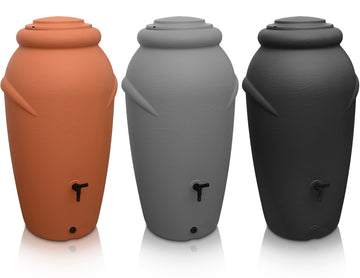
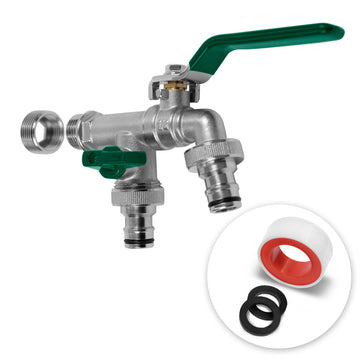
![Drei hohe YourCasa Regentonne 240 Liter [Wellen-Design] - Frostsicher & UV-beständige Gartentöpfe in den Farben Schwarz, Grau und Terrakotta, jeweils mit Drainagesystem für nachhaltige Bewässerung.](http://yourcasa.de/cdn/shop/files/ohnelogo_b8aeecac-557e-4106-a999-e77dcd160209.jpg?v=1707130230&width=360)
